Physical Address
304 North Cardinal St.
Dorchester Center, MA 02124
Oral and maxillofacial pathology is the specialty of dentistry that is involved in the histopathological and clinical diagnosis, as well as management of diseases of the oral mucosa and supporting bone and soft tissues, teeth, salivary glands, lip vermilion, and perioral skin. It would be impossible to discuss diseases affecting all of the above entities in one chapter. As such, this chapter is confined to the more common and distinctive mucosal lesions that are often seen and biopsied by the oral and maxillofacial surgeon, dermatologist, or otorhinolaryngologist. If a condition presents on the skin in addition to the mouth (such as pemphigus), only a brief mention of the oral manifestations is made since the topic will have been covered in detail elsewhere in this book.
From a histologic perspective, the oral mucosa is divided into nonkeratinized and keratinized sites. The former include the lip mucosa (wet inner surface of the lip), buccal mucosa, maxillary and mandibular sulcus/vestibule, ventral tongue, floor of mouth, soft palate, nonattached gingiva, and crevicular epithelium. The crevicular epithelium is the continuation of marginal gingival epithelium where it turns to face the tooth. Any keratin on these surfaces is considered abnormal and should be reported as such. The linea alba (‘bite line’) which is located on the buccal mucosa where the upper and lower teeth meet may be thinly parakeratinized, and this is considered within the realm of normal ( Fig. 11.1 ).

Normally, orthokeratinized sites include the hard palatal mucosa and the attached gingiva (extending from the cervix of the tooth for a band of 2–5 mm) while the tongue dorsum is normally parakeratinized. The tongue is a specialized structure because of its role in taste sensation, and has filiform, fungiform, circumvallate, and foliate papillae, with the last three containing taste buds ( Fig. 11.2 ). The taste buds are innervated by the subgemmal neurogenous plaque best seen in the posterior lateral tongue ( Fig. 11.3 ).
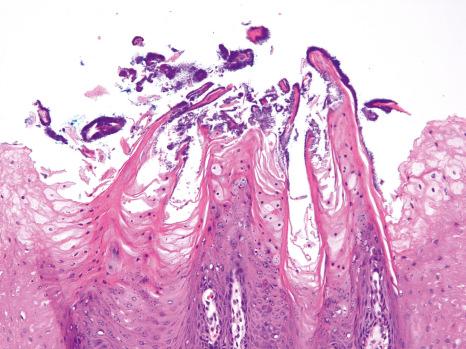
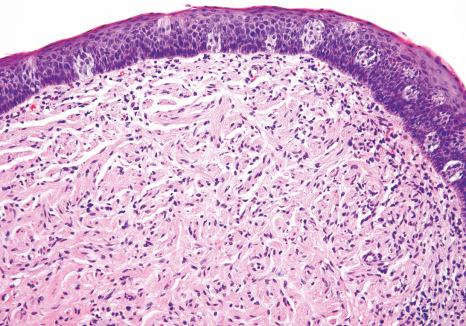
The oral mucosa consists of epithelium and underlying lamina propria that can be arbitrarily divided into superficial and deep portions, and underlying muscle or bone. Because there is no muscularis mucosa, there is no true submucosa. The epithelium of the oral mucosa is thickest on the tongue dorsum (20–25 cells thick), moderately thick on the buccal and lip mucosa (15–25 cells thick), and thinnest on the floor of mouth, ventral tongue, and soft palate (8–15 cells thick) ( Fig. 11.4 ). Pathologists not familiar with this feature tend to diagnose normal buccal, lip, or tongue epithelium as being acanthotic or exhibiting psoriasiform hyperplasia. The attached gingiva and the hard palatal mucosa abut the periosteum so that the deep lamina propria appears densely fibrotic ( Fig. 11.5 ). A diagnosis of ‘fibrosis’ is therefore inappropriate since this feature is normal for the site.
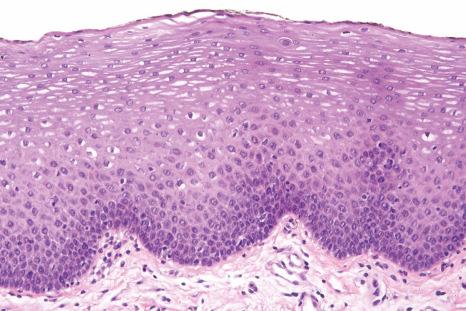
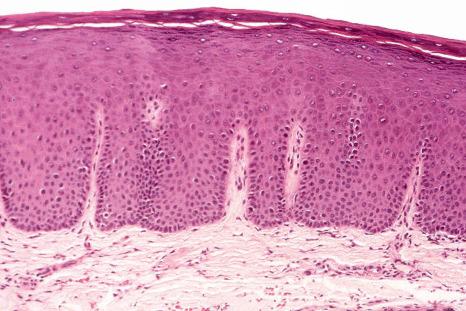
The tooth is composed of an outer highly calcified thin shell of enamel on the visible crown of the tooth; the non-visible portion within the bone is covered by cementum, which is similar in composition and appearance to bone. The bulk of the tooth consists of tubular dentin and the dental pulp containing fibrovascular and neural tissues (the source of most toothaches) courses through the length of the tooth. Odontogenic rests of Serres are common within the gingiva, and these consist of nests of squamous epithelium that may exhibit clear cytoplasm and sometimes show palisading of the basal cell nuclei ( Fig. 11.6 ).
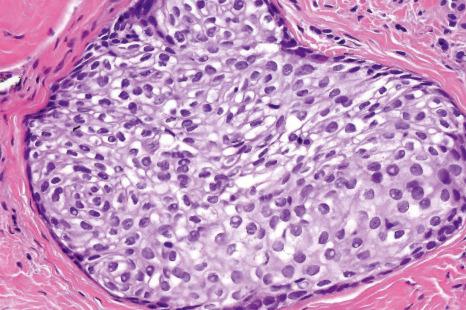
White sponge nevus (Canon white sponge nevus) is an autosomal dominant condition with high penetrance and variable expressivity. Onset is in early childhood, with 50% of patients diagnosed before age 20. The buccal mucosa is almost invariably affected, and other commonly affected sites are the lip mucosa, tongue, alveolar mucosa, and the floor of mouth. Nasal, esophageal, vaginal, anal, and penile mucosae may be involved, but not that of the conjunctiva, although there is one report of associated colobomas. Lesions appear as painless, diffuse, white–gray, spongy, folded plaques ( Fig. 11.7 ).
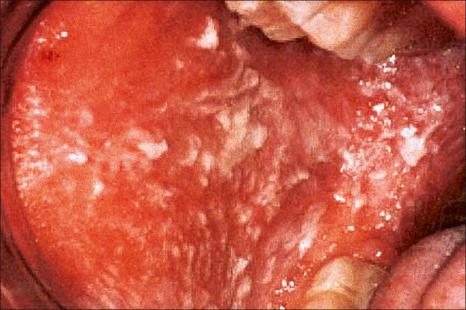
White sponge nevus is caused by a mutation in the helical domain of mucosal-specific keratins K4 (on chromosome 12q) and K13 (on chromosome 17q). The mutations are in the form of amino acid deletions, substitutions, and insertions resulting in keratin filament instability and abnormal aggregation of tonofilaments. Cases reported to have resolved with antibiotic therapy are not likely to represent this condition but rather reactive/frictional keratoses.
There is parakeratosis and acanthosis with the formation of broad, blunt rete ridges ( Fig. 11.8 ). Dyskeratotic cells exhibit dense peri- and paranuclear eosinophilic condensations, with vacuolation of cytoplasm at the periphery of the keratinocyte resulting in a falsely ‘spongiotic’ appearance on low magnification; there is insignificant inflammation ( Fig. 11.9 ). Parakeratin plugs and streaks have been noted beneath the superficial keratinocytes. One case that exhibited foci of epidermolytic hyperkeratosis has been documented.

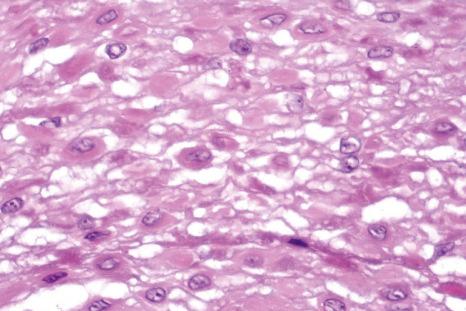
The eosinophilic condensations correspond to tonofilament aggregates in a peri- and paranuclear location. Organelles tend to segregate and are absent in vacuolated areas. Odland bodies are abundant within keratinocytes, but few are present in the intercellular spaces, suggesting a lack of acid phosphatase leading to retention, rather than normal shedding, of superficial cells.
This autosomal dominant disorder of the eye and oral cavity was first described in a tri-racial isolate (Caucasian, Native American, and African) in North Carolina called the Halowar, Haliwa, or Haliwa-Saponi Native Americans. Because of migration, cases have been reported in descendants living now in New York, Pennsylvania, Virginia, and Washington, DC.
The eye lesions, which usually present by the first year of life, are gelatinous plaques in the bulbar conjunctiva in a perilimbic distribution both nasally and temporally. Patients experience eye irritation often with a sensation of foreign material in the eye, and photophobia, and there may be exacerbations in spring. Corneal vascularization sometimes leads to visual loss.
Oral involvement is asymptomatic and is therefore generally not noticed until the second decade. Lesions involve the buccal and lip mucosa, floor of mouth, lateral and ventral tongue, and gingiva, but not usually the dorsum of tongue or uvula. The mucosa is white, opalescent, spongy, macerated, folded, and shaggy, often resembling white sponge nevus ( Fig. 11.10 ). There is generally no involvement of genital, nasal, or rectal mucosa.
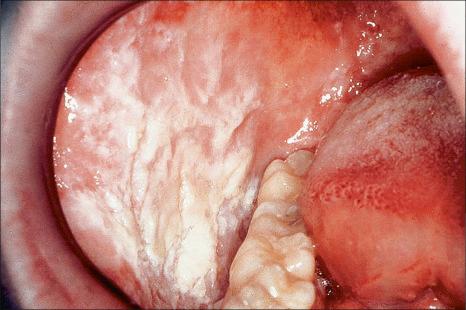
Genetic studies have localized the gene for this condition to chromosome 4q35 with a duplication segregating in affected individuals.
There is parakeratosis and acanthosis ( Fig. 11.11 ). Dyskeratotic cells (also called ‘tobacco cells’ because of their orange-brown color on Papanicolaou-stained smears) are present in the mid to upper one-third of the epithelium, appearing engulfed by adjacent normal keratinocytes; this ‘cell-within-a-cell’ appearance is a characteristic feature and is well seen in cytological smears ( Fig. 11.12 )

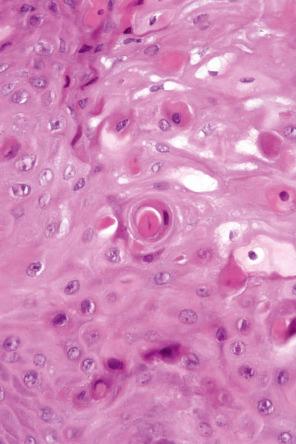
The dyskeratotic cells are packed with tonofilaments and vesicular bodies that may represent Odland bodies. Some keratinocytes also show loss of cellular interdigitations and desmosomes.
This rare genodermatosis is characterized by nail dystrophy, palmoplantar keratoderma, follicular keratoses, epidermoid cysts, and keratotic oral plaques; other findings include hyperhidrosis, hoarseness, angular cheilitis, and dental findings such as natal teeth. Nomenclature for this condition has been revised and is now based on molecular and genetic data. For example, patients with mutations in KRT6a and KRT16 are now designated pachyonychia congenita (PC)-K6a and PC-K16, respectively, rather than jointly as having Jadassohn-Lewandowsky syndrome (see below). The oral findings, usually noted within the first two decades of life and often at birth, are characterized by focal or generalized white keratotic plaques on the dorsum and lateral borders of the tongue, and buccal mucosa and are present in almost all patients with PC-K6a and in 40–50% of patients with PC-K6b and PC-K16. Natal teeth are seen in over 80% of patients with PC-K17.
Pachyonychia congenita is inherited as an autosomal dominant disorder characterized by mutations in five main keratin genes expressed in the nail bed, palmoplantar epidermis, and oral mucosa. These genes are KRT6a , KRT6b , KRT6c , KRT16 , and KRT17 , and nomenclature for this condition now reflects these genetic mutations and have replaced Jadassohn-Lewandowsky and Jackson-Lawler syndromes. There is a defect in the association of protein subunits in the assembly of keratin filaments leading to fragility of epithelial cells, and reduced strength and resilience to trauma.
There is parakeratosis or hyperkeratosis, acanthosis, intracellular vacuolization, and perinuclear eosinophilic condensations (likely tonofilaments). Because pachyonychia congenita and dyskeratosis congenita are generally diagnosed on skin biopsy, there are few detailed reports on the histology of oral lesions. Unlike true leukoplakia that develops in dyskeratosis congenita, the oral keratotic plaques of pachyonychia congenita have no malignant potential.
Cannon white sponge nevus also exhibits perinuclear eosinophilic condensations because of abnormal tonofilament aggregation, but does not exhibit skin or nail involvement.
Dyskeratosis congenita (Zinsser-Engman-Cole syndrome) is a genodermatosis that is associated with nail dystrophy, poikiloderma, oral leukoplakia, and development of pancytopenia and bone marrow failure, often requiring hematopoietic stem cell transplantation. The mucosa of the conjunctiva, urethra, and genital tract may also be involved. Oral leukoplakia, particularly of the tongue, presents in the second decade of life in at least 65% of cases, and has a high propensity for developing dysplasia and/or squamous cell carcinoma at an early age; teeth have short roots and are mildly taurodontic. Early oral lesions on the gingiva may be erythematous and erosive.
Dyskeratosis congenita is considered a premature aging syndrome or telomeropathy caused by poor telomere maintenance with mutations in DKC1 , TERC , TERT , TINF2 , and other genes.
The lesions of leukoplakia exhibit parakeratosis, and/or hyperkeratosis with variable dysplasia or invasive squamous cell carcinoma. Early lesions may exhibit only hyperkeratosis or parakeratosis but are still likely to represent ‘keratosis of unknown significance’ with the potential to subsequently develop dysplasia, unlike the keratoses noted in pachyonychia congenita or other genodermatoses (see earlier).
Oral findings occur in approximately 50% of patients with Darier disease (Darier-White disease, keratosis follicularis) and does not occur in the absence of skin findings. Mild involvement comprises minute white or pink keratotic papules, while more extensive disease results in larger plaques or a cobblestone mucosal surface. Lesions are generally asymptomatic. The palatal mucosa is the most common site affected, perhaps because of its normally keratinized nature, followed by the gingiva, tongue, buccal mucosa, and floor of mouth; the lips are rarely involved. Recurrent parotid or submandibular swelling may be reported in up to approximately one-third of cases and is most likely the result of strictures in the main duct causing obstruction. In general, the degree of oral involvement parallels the extent of skin lesions.
This disease is associated with a mutation of ATP2A2 on chromosome 12q that encodes a sarcoendoplasmic Ca 2+ -ATPase isoform 2 (SERCA) that is involved in cytoplasmic calcium transport which is required for post-translational processing and proper functioning of desmosomes and keratin.
There is hyperkeratosis, acanthosis, and suprabasal clefting with acantholysis forming villous-like projections that protrude into the cleft. Corps ronds and grains may not be as prominent as in skin lesions. Papanicolaou-stained smears show an orange-brown staining of the dyskeratotic ‘grains’ and refractile concentric perinuclear rings and granular bands in corps ronds. Excretory salivary ducts may become metaplastic or be involved by the same process leading to stricture formation and obstruction.
Oral warty dyskeratoma has similar histopathological findings although usually with few or no corps ronds or grains; it occurs as a solitary papule, plaque, or umbilicated nodule on the hard palatal mucosa or gingiva in the fifth and sixth decades of life, and as such, is distinguished from Darier disease by its clinical presentation.
Pemphigus vulgaris and pyostomatitis vegetans both exhibit acantholysis but not generally dyskeratosis; pemphigus shows intercellular IgG deposits on direct immunofluorescence while pyostomatitis vegetans exhibits intraepithelial eosinophilic abscesses.
The majority of these lesions (93%) occur as sessile or pedunculated masses on the posterior dorsum of the tongue, near the foramen cecum, although it may occur at other sites such as the buccal mucosa. Most develop in the second and third decades, and females are three to five times more likely to be affected. There may be dysphagia.
Theories of origin include ossification of branchial arch remnants, metaplastic bone formation secondary to trauma, and osteogenesis of unknown cause from multipotent mesenchymal cells in the area.
The lesion consists of a well-circumscribed mass of viable lamellar bone with haversian systems and variable osteoblastic rimming, surrounded by fibrous connective tissue; hematopoietic and fatty marrow or even cartilage may be present ( Figs 11.13 and 11.14 ).
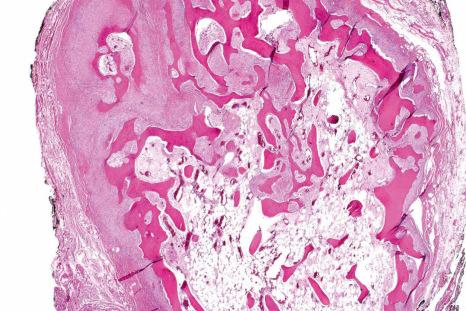
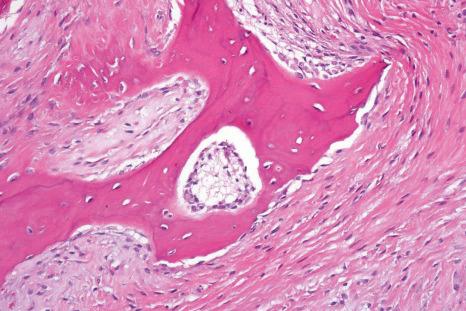
Osseous metaplasia may be noted within pleomorphic adenoma or lipoma, and within myositis ossificans.
Cartilaginous choristomas present as discrete nodules, usually on the lateral border of the tongue (85% of cases) and less often on the buccal mucosa and soft palate. Most occur in adults.
They may represent developmental malformations that arise from multipotent mesenchymal cells of the tongue, metaplastic change secondary to trauma or cartilaginous rests.
Cartilaginous choristoma consists of a mass of benign mature hyaline cartilage surrounded by perichondrium; loose myxoid tissue containing spindle cells reminiscent of primitive mesenchyme, or even mature fat may also be present. Some cases show ossification. Rare cases of chondrosarcoma have been reported.
Metaplastic cartilaginous nodules are often seen in cases of denture-associated fibrous hyperplasia (Cutright tumor), but these occur in the maxillary and mandibular vestibules associated with denture flanges. Cartilaginous rests are also common in the area of the nasopalatine canal. Some authors believe that cartilaginous rests of the soft palate/tonsillar area are a metaplastic phenomenon, occurring in 20% of tonsils examined. A pleomorphic adenoma with extensive chondroid metaplasia should be considered in the differential diagnosis, but this would contain ductal structures and myoepithelial cells.
Oral sebaceous glands or Fordyce granules occur as 1–3-mm yellow macules or papules in the buccal and lip mucosa, and vermilion in approximately 80% of the adult population ( Fig. 11.15 ). However, these may become hyperplastic (sebaceous hyperplasia) or adenomatous (sebaceous adenoma), forming painless papules, plaques, or nodules; rarely, these may be associated with Muir-Torre syndrome. They occur in the same sites as Fordyce granules.
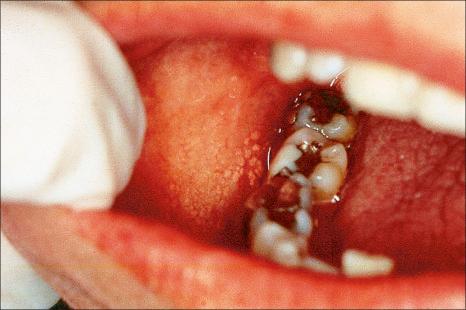
Rare cases of sebaceous choristomas have been reported in adults or infants. They present as dome-shaped masses in the midline of the dorsum in the area of the middle or posterior one-third of the tongue.
Fordyce granules are generally considered a variation of normal anatomy and consist of mature lobules of sebaceous glands that may communicate with the surface epithelium via a duct. There may be pseudocyst formation with retention of secretions; the rare occurrence of hair follicle and Demodex within a Fordyce granule has been reported.
In sebaceous hyperplasia, at least 15 lobules (a somewhat arbitrary number) of mature sebaceous glands empty into ducts that communicate with the surface ( Fig. 11.16 ). Sebaceous adenomas, in addition, show a proliferation of basaloid germinative cells at the periphery of the lobules. Some of these may represent sebaceous adenoma of the minor salivary gland. The term sebaceous choristoma has been used to described mature sebaceous units usually in the midline present in infants. However, if it is associated with eccrine glands, hair follicles, and apocrine glands, it is more appropriately termed epidermal choristoma. Rarely, sebaceous carcinoma develops intraorally.
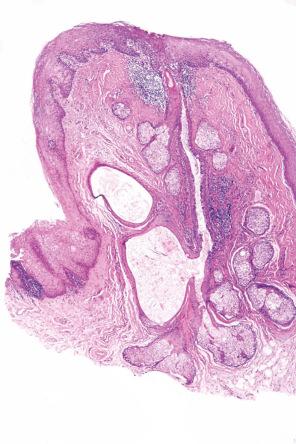
Almost all of these are cystic lesions that present as swellings of the tongue, usually ventral midline, or the floor of mouth. Sometimes they appear as sinus tracts. They are most often seen in infancy or early childhood and may be associated with orofacial malformations.
Theories of pathogenesis include epithelial entrapment, displacement, or persistence of intestinal epithelial buds that subsequently proliferate and differentiate.
The cystic lesions are lined by epithelium typical for the cardiac, fundic, or pyloric regions of the stomach with parietal and Paneth cells. However, some are lined by squamous, colonic, and/or ciliated epithelium ( Fig. 11.17 ). Smooth muscle is usually identified, and the presence of pancreatic tissue has also been reported. If ectodermal and mesodermal elements are also present, the lesion should be considered a teratoma.
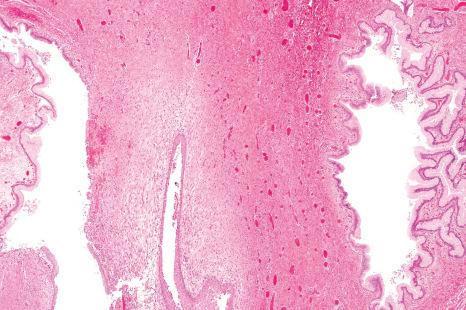
This uncommon condition presents in the first year of life, most often affecting the palatal mucosa, tongue (especially the foramen cecum area), or oropharynx presenting as a nodule or mass. Some patients have associated palatal defects. Respiratory obstruction is a major cause of morbidity, and feeding difficulties are common if lesions are large.
It occurs as a result of displacement of primitive neural elements in an early stage of development, or neuroglial differentiation from multipotent cells.
Mature elements of the central nervous system including astrocytes, oligodendrocytes, ependymal tissue, and choroid plexus-like tissue, and, rarely, neuronal tissue may all be identified ( Fig. 11.18 ).
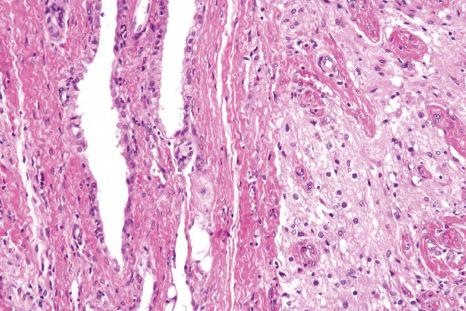
Oral lymphoepithelial cysts generally occur in the fourth decade of life with a 2 : 1 female predilection. These also occur in the parotid gland, in particular, in human immunodeficiency virus (HIV)-positive individuals. They present as painless, yellowish nodules, usually less than 1 cm in diameter, most commonly affecting the floor of mouth followed by the posterior ventral tongue, soft palate, and tonsillar fauces ( Fig. 11.19 ). They are commonly filled with cheesy, keratinaceous material. Some authorities believe that lesions that present at sites where tonsillar tissue is normally found represent blocked tonsillar crypts with retention of secretions.
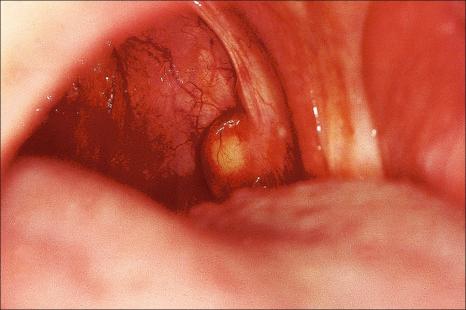
Three theories of pathogenesis have been proposed:
There is enclavement of epithelium within oral lymphoid tissue during embryogenesis and subsequent proliferation and cystic degeneration.
Such lymphoid aggregates are ectopic oral tonsils, where the crypt openings have been blocked, resulting in retention of secretions.
The epithelium represents squamous metaplasia of excretory salivary ducts, and the lymphoid tissue is a reaction to inflammation or immunological stimulation.
The last theory is particularly pertinent in floor of mouth lesions, a site where tonsillar/lymphoid tissue is not normally found.
The cyst is lined by parakeratotic stratified squamous epithelium and the lumen is filled with desquamated keratinaceous material ( Fig. 11.20 ). Rare cases may be lined by pseudostratified columnar epithelium with or without mucous cells. The epithelium usually demonstrates lymphocytic exocytosis and resembles the reticulated lymphoepithelium of the tonsils. The surrounding lymphoid tissue may encircle the cyst epithelium completely or partially, and germinal centers may be well formed or absent ( Fig. 11.21 ). Some cases demonstrate communication with the overlying surface epithelium, often through a narrow opening.
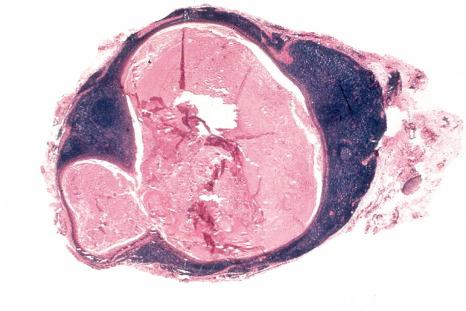
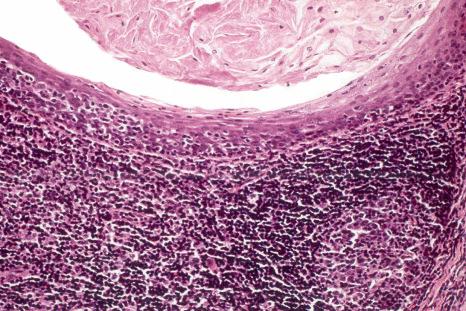
Salivary glands and ducts may be present in the vicinity, especially floor of mouth lesions.
Salivary duct cysts are lined by stratified squamous, columnar, oncocytic, or respiratory epithelium, sometimes with mucous cell prosoplasia. They may show foci of chronic inflammation but not usually the thick mantle of lymphocytes with germinal centers. Dermoid and epidermoid cysts lack the lymphoid mantle and produce orthokeratin, and dermoid cysts contain adnexa in the wall.
This usually occurs in children and young adults, and there may be a slight male predilection. The midline floor of the mouth is the most common site of presentation, and some cases are congenital. Classification of these lesions is based on anatomical location such as lingual, submental or submandibular, and on the histologic appearance. The term ‘congenital germline fusion cyst” has been proposed for these lesions.
They present as dome-shaped, yellow masses with a rubbery or doughy consistency. Intraoral lesions cause feeding, swallowing, and speech difficulties while extraoral variants below the myohoid muscle lead to a noticeable submental mass. Dumbbell-shaped cysts have both intra- and extraoral swellings.
One theory suggests that these cysts arise from entrapped epithelial rests in the line of fusion of the first and second pharyngeal arches. Another proposes that the lining develops from displaced embryonic rests or traumatic implantation, possibly occurring even in utero. Some authorities suggest a single term, ‘congenital germline fusion cyst’, for epidermoid, dermoid, and teratoid cysts.
Both epidermoid and dermoid cysts are lined by orthokeratinized squamous epithelium, and the lumen is filled with keratinaceous material. Epidermoid cysts (also called epithelial inclusion cysts) have no adnexa in the wall, while dermoid cysts always have hair follicles, sebaceous glands, and/or eccrine or apocrine structures in the wall. Oral dermoid cysts are three times more common than epidermoid cysts. Some cysts also contain gastrointestinal mucosa or respiratory mucosa. If tissues from all three germ layers are represented, the term ‘teratoid cyst’ is applied.
Gingival cyst of the adult is generally nonkeratinized and is lined by low cuboidal to columnar or stratified squamous epithelium, with occasional epithelial plaques containing clear cells. Gingival cysts of the newborn, which are not biopsied because they exteriorize on their own, are filled with keratinaceous material. Both can be differentiated from epidermoid cysts by their location on the gingiva.
These rare conditions generally present congenitally or in infancy as masses protruding from the mouth, causing respiratory distress and feeding difficulties. They have been classified as follows:
dermoid tumor (‘hairy polyp’) where only ecto- and mesodermal structures are present,
teratoid tumor and teratoma with tissue from all three germ layers represented; the tissues in teratoid tumor are not as well organized as in a teratoma,
epignathus where there is recognizable organ and limb formation; however, this term is also often applied to any teratoid tumor or teratoma that arises from the nasopharyngeal or palatal areas with epignathus being the most mature variant.
Of these, the dermoid is the most common.
Dermoids tend to occur in females (six to seven times more often than in males) as pedunculated masses in the nasopharynx, oropharynx, and soft palate. The mass is covered by skin, hence its other name, ‘hairy polyp’. It may also grossly resemble an accessory auricle.
Teratomas, teratoid tumors, and epignathi present as masses that may protrude from the mouth, and airway obstruction is a frequent presenting symptom; there is a female predilection and most are present at birth. Unlike dermoids, these tumors are often associated with other malformations and findings such as elevated alpha fetoprotein and polyhydramnios.
Epignathi in particular may be associated with severe congenital malformations, and stillbirth is a common occurrence. They most often arise from the hard palatal mucosa (hence its name), although the posterior nasopharynx and upper lip can be involved, and there may be palatal clefts and cranial extension. Grossly, the tumor sometimes contains rudimentary limbs, or even a head resembling an incomplete twin or fetus in fetu.
Lingual (tongue) teratomas are generally not associated with such developmental defects.
Dermoids are covered by skin with its constituent adnexa. In addition, cartilage, bone, muscle, and adipose tissue may be present ( Fig. 11.22 ). Teratomas contain tissue derived from all three germ layers to include ectoderm, mesoderm, and endoderm. As such, neural, brain, lung, gastrointestinal, and respiratory tissues may be present.
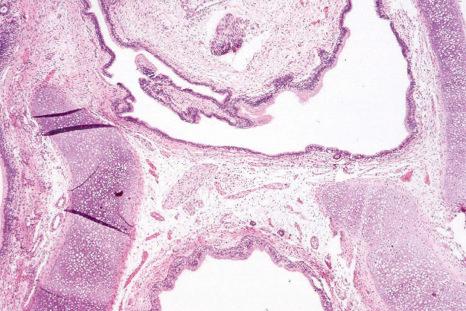
Epignathi is a form of duplication and consist of tissues organized to form grossly recognizable specific organ systems such as limbs, a head, or eyes.
The congenital granular cell tumor presents as a pink, pedunculated mass, usually on the anterior alveolar ridge mucosa with an intact surface ( Fig. 11.23 ). There is a 10 : 1 female predilection, and it is three times more common in the maxillary mucosa. It may cause problems with nursing. Approximately 9% of patients have multiple tumors and some may have concurrent tongue lesions.
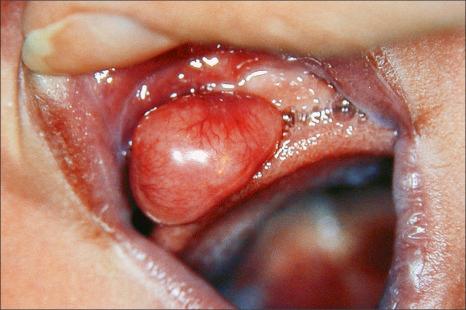
Theories of histogenesis have included pericytic, myofibroblastic, and neural differentiation. The current hypothesis is that it represents a mesenchymal tumor with degenerative change. This is supported by lack of growth after birth of the infant, resolution of some cases over time, histologic evidence of degeneration, and lack of recurrence in spite of incomplete removal.
Histologically, a Grenz zone may or may not be present and the overlying epithelium is typically atrophic without pseudoepitheliomatous hyperplasia. The cells are round or polygonal with distinct borders, abundant eosinophilic granular cytoplasm, eccentric small nuclei, and inconspicuous nucleoli; a prominent delicate and arborizing capillary network is usually evident ( Fig. 11.24 ). The granules are periodic acid-Schiff (PAS) positive and diastase resistant; odontogenic rests may also be present.
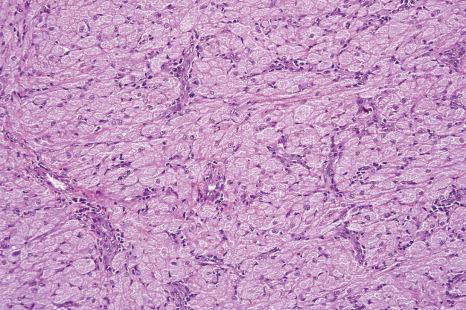
The granular cells do not express S100 protein but are always vimentin positive and CD68, NK1C3, and PGP9.5 positive; 40% are also positive for neuron-specific enolase (NSE). Studies for smooth muscle actin (SMA), estrogen and progesterone receptors, glial fibrillary acidic protein (GFAP), myelin basic protein (MBP), and neurofilament protein are negative. ,
Ultrastructural studies reveal the presence of membrane-bound granules with electron-dense contents that most likely represent phagolysosomes. The presence of subplasmalemmal dense bodies, pinocytotic vesicles containing precollagenous material, and intracytoplasmic laminin and fibronectin suggests myofibroblastic differentiation.
The cells of conventional granular cell tumor are histologically indistinguishable from those of congenital granular cell tumor. However, in congenital granular cell tumor, there is no pseudoepitheliomatous hyperplasia and there is a prominent arborizing delicate vascular network; importantly, the cells are S100 negative. Angulate bodies, seen ultrastructurally in conventional granular cell tumor, are absent.
Congenital gingival leiomyomatous polyp/hamartoma has a similar clinical presentation (usually in the midline of the maxillary mucosa) but histologically contains a nonencapsulated proliferation of fusiform and spindle smooth muscle cells that, as expected, express HHF-35, SMA, and desmin but not S100 protein. This condition may also occur at other sites.
Approximately 10% of cadaveric tongues contain nests of thyroid tissue, with no sex predilection. However, when thyroid tissue occurs as a mass in the tongue, the term ‘lingual thyroid choristoma’ or ‘ectopic lingual thyroid’ is used. Since approximately 86% of such tumors consist of the only thyroid tissue in the body, the terms ‘lingual thyroid’ or ‘ectopic lingual thyroid’ are more accurate.
Females are three to seven times more likely to be affected than males and there are two peaks of presentation, i.e., the first and second decades and the fifth and sixth decades, probably related to hormonal influences. The lesion presents as a rounded, soft-to-firm mass within the base of the tongue between the foramen cecum and the epiglottis. It may cause dysphagia, dyspnea, dysphonia, or a globus sensation, and hemorrhage may occur. One-quarter of patients may be hypothyroid.
The thyroid anlage develops in the area of the foramen cecum and descends from there into the neck. As such, failure to descend or persistence and proliferation of remnants of the anlage results in a noticeable mass. In most cases, a biopsy is not indicated if imaging studies are positive for thyroid tissue. However, difficulty swallowing may necessitate excision.
The tissue consists of thyroid follicles that contain mature or embryonic thyroid epithelium and exhibit microfollicular, macrofollicular, or adenomatous changes. There may be an associated thyroglossal duct. Follicular and papillary carcinomas can sometimes occur, in the same frequency as one would expect in the normal thyroid gland ; even medullary carcinoma has been reported.
Lymphangioma has been identified in approximately 4% of infants, all of whom were black. Females are twice as likely to be affected as males, and 74% of subjects have more than one lesion. They present as dome-shaped, bluish, fluid-filled vesicles usually affecting the posterior maxillary and mandibular alveolar ridge mucosa and are typically 3–4 mm in diameter. Many (if not most) regress by 6 months of age.
Lymphangioma is characterized by slit-like spaces lined by flattened endothelial cells and filled with sparse, fibrillar, eosinophilic material consistent with lymph, and often red blood cells. Odontogenic rests sometimes may be present.
Lymphangioma circumscriptum has an identical histology but is seen in older patients.
In this condition, there is a benign, diffuse, nonhemorrhagic, and fibrotic gingival enlargement, often occurring bilaterally and involving the maxillary and mandibular gingiva, sometimes to the extent that it may reach the occlusal/incisal edges of the teeth. Several forms are recognized. The inherited form (usually an autosomal dominant trait, but occasionally autosomal recessive), which is less common, tends to present congenitally or in the first decade of life, coinciding with eruption of teeth, and often exhibits generalized gingival involvement. The gingival growth is densely fibrotic and covered by normal-appearing mucosa ( Fig. 11.25 ). There is a strong association with hypertrichosis and mental retardation and/or seizure disorders, and medications such as phenytoin taken to control seizures aggravate the gingival hyperplasia. Gingival fibromatosis is also a feature of Zimmerman-Laband, Ramon, Rutherford, Cross, and other syndromes. An idiopathic form occurs later in life usually with limited involvement of the gingiva by similar fibrotic masses often confined to just one quadrant, or to the maxillary tuberosity or lingual mandibular mucosa bilaterally. There is no tendency for regression.
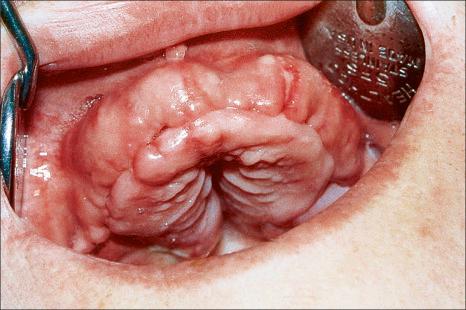
The nonsyndromic, autosomal dominant form of the disease is caused by a mutation in SOS1 on chromosome 2p21–22.
The gingival overgrowth is caused primarily by an increased production and reduced metabolism of connective tissue. Native fibroblasts show elevated rates of proliferation and increased synthesis of fibronectin and type I collagen. Reduced matrix metalloproteinase levels, possibly mediated by increased production of transforming growth factor beta-1 (TGF-β1), results in excess accumulation of extracellular matrix.
Histologically, there is a diffuse proliferation of collagenous tissue within a background of excessive ground substance ( Fig. 11.26 ). Some lesions contain plump, stellate-shaped fibroblasts ( Fig. 11.27 ). Dystrophic calcification may be seen in up to 43% of cases. The overlying epithelium is variably acanthotic, and there are few inflammatory cells.
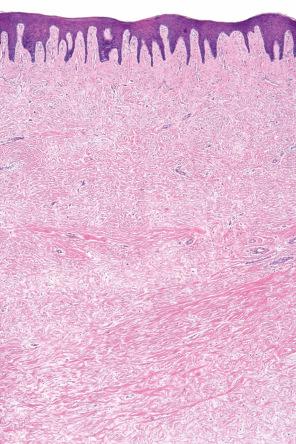
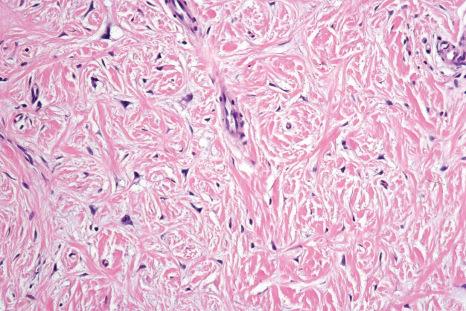
Generalized gingival hyperplasia caused by local irritation or systemic influences (such as medications or hormones) is distinguished from gingival fibromatosis on clinical grounds and by more prominent inflammation.
Hyaline fibromatosis is an autosomal recessive condition with two distinct subgroups, although both exhibit joint contractures, skin papules and nodules, gingival hyperplasia, and osteopenia. In the less severe form referred to as juvenile hyaline fibromatosis, patients exhibit pearly papules and larger fibrotic nodules on the skin (around the face, ears, scalp, neck, and trunk) and survive for several decades, while the more severe form referred to as infantile systemic hyalinosis exhibits systemic involvement, skin hyperpigmentation, perianal nodules, protein-losing enteropathy with diarrhea, recurrent infections, and survival of less than 2 years.
Mutations of capillary morphogenesis factor 2 gene, ANTXR2 , on chromosome 4q21 causes defects in basement membrane matrix assembly resulting from compromised cell-matrix or cell-cell interactions.
The gingival and skin lesions of juvenile hyaline fibromatosis show extensive deposits of PAS-positive, diastase-resistant, and Congo red-negative homogenous, eosinophilic, hyalinized material in the connective tissue ( Fig. 11.28 ). Fibroblasts are round and chondrocyte-like, lying within lacunae-like spaces and exhibit large vesicular nuclei. The hyaline material consists of glycoproteins, glycosaminoglycans, and collagens.
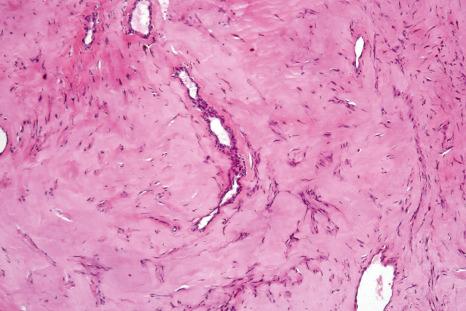
Ultrastructurally, there are prominent Golgi complexes, dilated rough endoplasmic reticulum, and multivesicular bodies and vesicles filled with fibrillogranular material that resembles collagen. 12
This is a benign, painless condition of adults, usually affecting the buccal mucosa bilaterally, and occasionally the tongue; it is not symptomatic. The mucosa has a diffuse gray-white hue with faint reticulations that disappear on stretching ( Fig. 11.29 ).
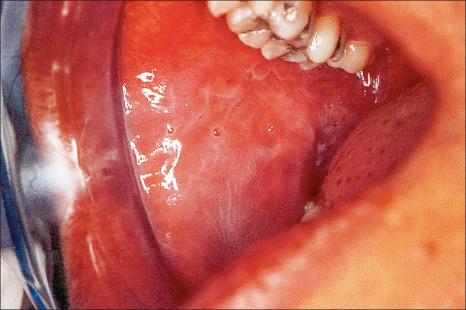
The prevalence ranges from 20% to 36% among those who do not use tobacco or chew coca leaves, to 51–68% in those who use tobacco, coca, or cannabis. Its incidence increases with age. A prevalence of 51% was reported in African-Americans but without mention of tobacco habits. Another study found a prevalence of 93% in a Caucasian population, leading the author to question whether this condition is merely a variation of normal.
A low-grade topical injury, such as occurs with the use of smoked tobacco or coca leaves, gives rise to this condition. As such, most changes are limited to the superficial layers of keratinocytes.
There is acanthosis with little or no parakeratosis. The characteristic feature is keratinocyte edema where degenerated and swollen cells are present in the superficial and mid-epithelial layers ( Fig. 11.30 ). The most superficial cells have abundant pale, watery cytoplasm, sometimes pyknotic nuclei and prominent collapsed cell membranes, forming a jigsaw puzzle pattern; anucleate forms are caused by plane of section of these swollen cells ( Fig. 11.31 ). There is usually no inflammation in the lamina propria.
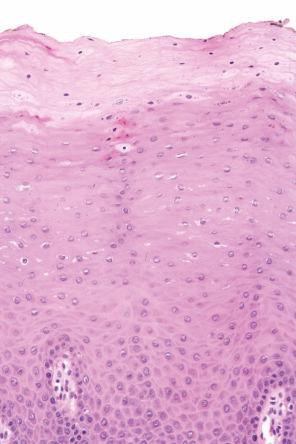
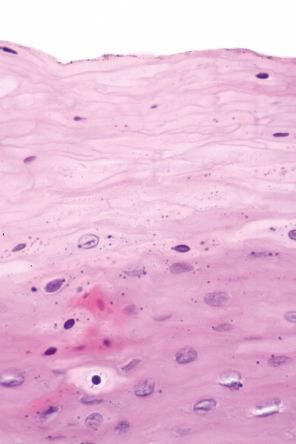
Ultrastructural studies show abnormal keratohyaline granules and loosely dispersed tonofilaments with fragmented organelles in the superficial degenerated cells. The mid-level swollen cells contain abnormal swollen mitochondria. These features support the theory of limited cell damage with keratinocyte edema and swelling. Similar features have also been reported in the sucking pads of neonates.
In morsicatio mucosae oris, there is shaggy parakeratosis associated with many bacterial colonies without inflammation; keratinocyte edema is often present beneath areas of such factitial keratosis (see below).
Smokeless tobacco lesion presents with keratin chevrons and shows a band of coagulated and degenerate cells with anucleation similar to leukoedema. The transition zone from normal to degenerate is often abrupt in smokeless tobacco lesion (see below). This should also be considered a severe form of keratinocyte edema caused by contact irritation.
Hairy leukoplakia may exhibit leukoedema and concomitant morsicatio mucosae oris, but will also exhibit viral cytopathic change caused by Epstein-Barr virus.
This is usually seen in adults, is often bilateral, and may involve the buccal mucosa (most common), lateral tongue, and lower lip mucosa. The site of injury exhibits shaggy white papules and plaques that have a peeling, thready, macerated surface; erosions are sometimes present, and occasionally ulcers are seen ( Figs 11.32 and 11.33 ). Similar lesions have been noted in areca nut chewers and glass blowers. This has no malignant potential.
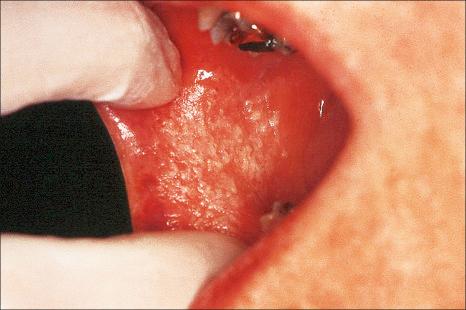
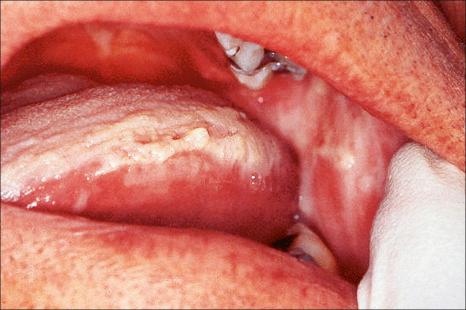
In morsicatio mucosae oris, buccal mucosa, lip, or tongue chewing habits occur either subconsciously at night or as a conscious parafunctional habit, leading to keratosis and maceration of the mucosa.
There is shaggy, irregular parakeratosis, which may be severe, and acanthosis. Characteristically, the keratin is thrown into papillations with fissures and clefts, rimmed by bacteria, but this is not invariably present ( Fig. 11.34 ). Spongiosis or leukocyte exocytosis are usually absent although plasma pooling may be present within superficial keratinocytes. Superficial cells are ballooned and degenerated, typical for keratinocyte edema. Inflammation in the lamina propria is insignificant unless there is erosion and ulceration. In betel nut chewers, there is a yellow-brown pigment on the surface of the keratin and within epithelial cells, representing fragments of the betel quid. Biopsy of the linea alba (the white line on the buccal mucosa bilaterally where the upper and lower teeth meet) essentially reveals identical histologic features confirming the frictional/factitial nature of this condition.
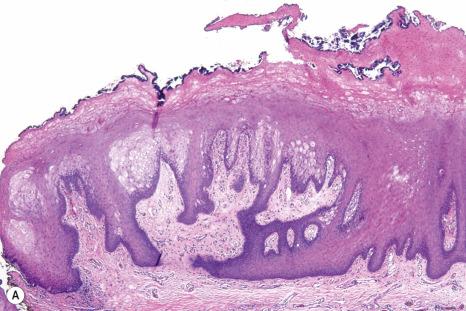
Morsicatio mucosae oris may occur as a primary mucosal disorder such as has been described above, or it may present as a secondary finding related to chronic injury of protuberant plaques and nodules, such as fibromas.
Hairy leukoplakia may show similar shaggy parakeratosis from trauma. However, the typical changes of chromatin condensation, amphophilic Cowdry inclusions, and the presence of Epstein-Barr virus easily afford their distinction.
Smokeless tobacco lesion shows sharply demarcated coagulation of the superficial cells, sometimes accompanied by hyalinized, amorphous eosinophilic material in the lamina propria.
This is a condition seen in adults on the keratinized mucosa. This presents as nontender, white, rough plaques that occur on the crest of the alveolar ridge mucosa, in particular in the area of the mandibular retromolar pads, often bilaterally ( Fig. 11.35 ). It may occur in any other part of the ridge mucosa where a tooth has been extracted. It has no malignant potential.
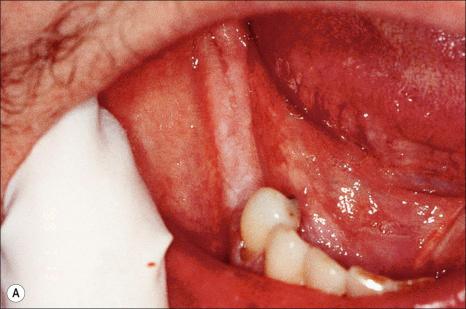
Lesions reported as merely ‘alveolar ridge keratosis’ are any white lesions on the alveolar ridge and gingiva with no histologic connotations and include both benign and dysplastic/malignant keratotic lesions of the gingiva and alveolar ridge; they are not synonymous with benign alveolar ridge keratosis, which has the specific histologic appearance of lichen simplex chronicus.
These lesions are caused by chronic frictional trauma to the ridge, not necessarily by direct tooth-to-ridge contact, but by food being crushed by teeth against the opposing edentulous ridge mucosa.
They have the typical histopathology of skin lesions of lichen simplex chronicus. There is hyperkeratosis often with wedge-shaped hypergranulosis, surface undulations or papillomatosis, and acanthosis ( Fig. 11.36 ). Rete ridges are tapered and generally uniformly elongated and often confluent at the tips. There is usually minimal to insignificant chronic inflammation in the lamina propria. Lesions from the retromolar pad often contain stellate-shaped fibroblasts, which are normal for that site.
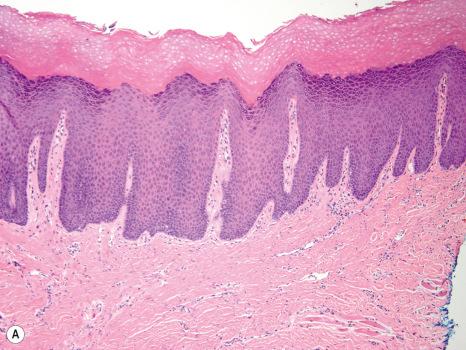
Verrucous hyperplasia may have a similar histology and often occurs on the gingiva or alveolar ridge mucosa; this is a form of architectural dysplasia (see later). However, the papillomatosis is usually more marked and other features include epithelial atypia, bulky epithelial hyperplasia, and an endophytic growth pattern. This must be correlated with clinical findings especially with a clinical lesion known as ‘proliferative verrucous leukoplakia’, where lesions are extensive, multifocal, and highly associated with malignant transformation.
In smokeless tobacco lesion (snuff dipper's keratosis), tobacco placed in the mandibular and less often, maxillary sulcus is associated with the development of white lesions at the site of contact in 13–46% of cases. The severity of oral lesions is proportionate to the duration of use and the amount of smokeless tobacco in contact with the mucosa.
This is a condition seen in teenagers and adults depending on acceptability of this habit within the culture. Early and mild lesions show slight wrinkling and pallor of the mucosa and discontinuation of the habit leads to resolution of lesions ( Fig. 11.37 ). Advanced lesions develop after many years of use and are well-demarcated white plaques with fissures, typical for leukoplakia, a premalignant condition (see later). Such leukoplakias are irreversible and have the same connotations for dysplasia and carcinomatous transformation as at other sites. Patients are prone to develop gingival recession and periodontal disease in the area of placement of tobacco.
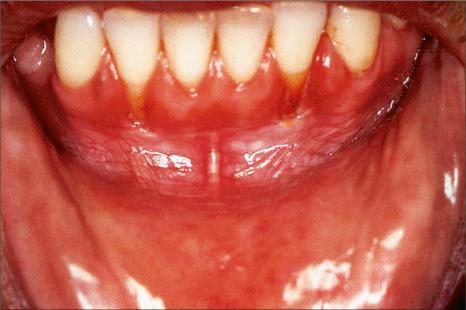
Smokeless tobacco takes the form of chewing tobacco (cured, shredded, and flavored tobacco leaves) or snuff which may be moist or dry. Moist snuff (known as snus in Scandinavia) is by far the more popular and is composed of finely cut or ground, cured, and flavored tobacco often available in pre-portioned pouches, while dry snuff, which has waned in popularity, is fermented, powdered tobacco rubbed onto the gingiva or inhaled. Snus has greater alkalinity (pH 8–9) and as such, better mucosal penetration, and a greater propensity to cause lesions compared with dry snuff. Sudanese snuff ( toombak ) is a mixture of tobacco and sodium bicarbonate and is highest in tobacco-specific nitrosamines. In general, the risk of developing oral cancer is less with smokeless tobacco than with cigarette smoking, although much depends on the composition of the product.
There is disturbed differentiation of keratin as evidenced by increased expression of K13 and K14 in patients using toombak as compared with those using Swedish snuff. Mutations in the p53 gene have been described.
The term ‘smokeless tobacco keratosis’ is somewhat of a misnomer because early lesions are not significantly keratotic. Rather, the clinical appearance of whiteness is a result of edema of the superficial keratinocytes from direct contact injury and is a form of irritant contact stomatitis.
Early lesions (before the development of leukoplakia) show a characteristic pale-staining surface layer of ballooned and edematous keratinocytes occasionally covered by a thin layer of parakeratin ( Fig. 11.38 ). Typically, this superficial pale layer is sharply demarcated from the underlying viable epithelium, which shows acanthosis and variable chronic inflammation. In addition, spires of parakeratin ‘chevrons’ are usually present within this pale surface zone although this finding is not specific to this lesion and may be seen in frictional or other reactive parakeratosis; there is nuclear pyknosis ( Fig. 11.39 ). Mild reactive epithelial atypia may be present, and lesions resolve on discontinuation of the habit. Sialadenitis of minor salivary glands has been reported in up to 42% of cases, and there is a reduction in the number of intraepithelial Langerhans cells.
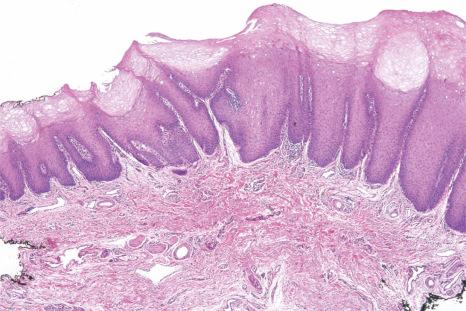
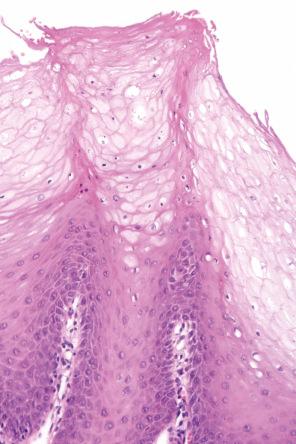
Hyaline deposits may be seen as a dense homogenous, eosinophilic band in the lamina propria in 8–17% of cases, and sometimes involving the gland parenchyma and surrounding ducts ( Fig. 11.40 ). This PAS-positive, noncongophilic material is not amyloid and is thought to represent altered collagen.
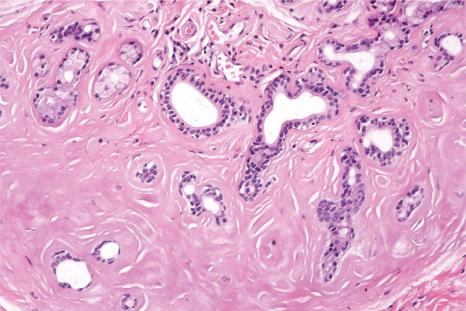
When leukoplakia develops, lesions should be evaluated for dysplasia in the same fashion as leukoplakias elsewhere (see later). Squamous cell carcinoma is an infrequent complication of smokeless tobacco use in the absence of cigarette smoking and/or excessive alcohol consumption.
Hyaline deposits resemble amyloid but are not congophilic.
Benign migratory glossitis (geographic tongue, geographic stomatitis, stomatitis/erythema areata migrans) occurs in 1–2% of the population (usually adults), although this figure may be low because of the evanescent nature of the condition. Pain, burning or sensitivity, may or may not be present. Lesions present as recurrent, erythematous, and atrophic areas with a serpiginous white, slightly raised border that may appear annular or scalloped ( Fig. 11.41 ). These ‘map-like’ areas migrate and change in shape over the tongue dorsum as the condition resolves at one edge and involves another. Some lesions, however, are stationary. Overall, 20–60% of patients have concurrent fissured tongue ; more than half the patients are atopic.
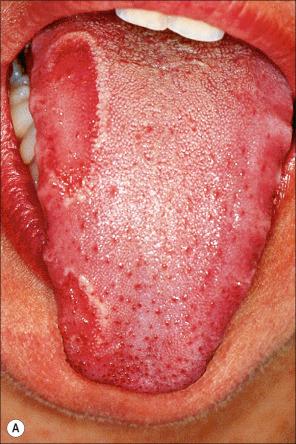
‘Ectopic geographic tongue’ or, more appropriately, migratory stomatitis, refers to a similar-appearing lesion at other sites, in particular the buccal and lip mucosae. Only 0.5% who present with benign migratory glossitis have psoriasis, but 5–14% of patients with psoriasis are affected by this condition. This prevalence is likely higher in patients with pustular disease. The condition also occurs in patients with reactive arthritis. Lithium carbonate (which can exacerbate psoriasis) has also been reported to precipitate migratory glossitis.
Human leukocyte antigen (HLA)-Bw62 and Bw63 are seen with higher frequency in affected patients and atopic individuals (odds ratio of 6.5), as well as in patients with associated type II diabetes mellitus lesions ; however, the association with diabetes mellitus has been refuted. There is also an increased incidence of HLA-C*06 and HLA-B13 in addition to a reduced incidence of HLA-Cw4. Other authors have shown increased incidences of HLA-DRw6, and -DR5 with reduced incidences of -B51 and -DR2. An increase in polymorphism in the interleukin (IL)-1β gene has been reported.
The tongue dorsum exhibits loss of the filiform papillae ( Fig. 11.42 ). There are spongiotic pustules and microabscesses (often involving up to half or more of the thickness of the epithelium) in the absence of Candida infection ( Fig. 11.43 ). The epithelium shows variable spongiosis and neutrophilic exocytosis, psoriasiform epithelial hyperplasia with broad rete ridges, edema of the lamina propria, a variable lymphocytic infiltrate, and dilated capillaries.
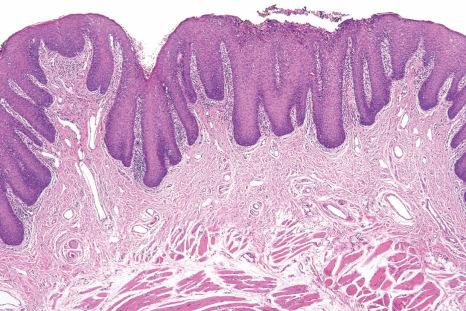
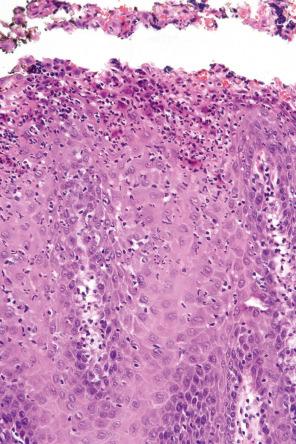
Candidiasis, which must always be excluded, more typically presents with spongiotic pustules affecting only the top two to three layers of keratinocytes. A PAS stain should be performed routinely for all oral lesions with spongiotic pustules. Median rhomboid glossitis, a form of candidiasis, also enters the differential diagnosis since it may have a somewhat similar clinical presentation with atrophy of filiform papillae, although the area does not ‘migrate’ (see below).
The epithelium at the edge of a healing ulcer or at sites of trauma often shows spongiotic pustules devoid of Candida accompanied by neutrophilic exocytosis.
Oral psoriasis is histologically indistinguishable from lesions of benign migratory glossitis, and up to 10% of patients with psoriasis develop migratory glossitis.
This condition occurs more often in females than in males (4 : 1), usually in the fifth decade. The gingiva presents with multifocal or diffuse erythema that is sensitive or painful in the majority of patients and often, there is a recent history of dental treatment. Some lesions are ulcerated.
Energy dispersive X-ray microanalysis have revealed Si, Al, Fe, Cu, and Ti in the majority of cases, and in many lesions, the analyses match those of dental abrasives. It is therefore thought that some of these cases result from such abrasives forced into the gingiva during professional dental cleaning. Some analyses also match those of amalgam.
The epithelium is acanthotic or atrophic, and basal cell degeneration is present in up to 50% of cases. The inflammatory infiltrate varies in severity and is lichenoid (bandlike and lymphocytic) in half the cases ( Fig. 11.44 ). In one-quarter of cases, granulomatous inflammation may be seen, sometimes accompanied by foreign body giant cells. Plasma cells may be abundant. Foreign bodies, ranging from 1 to 5 microns in diameter, are present in all cases, and 44% are refractile ( Fig. 11.45 ).
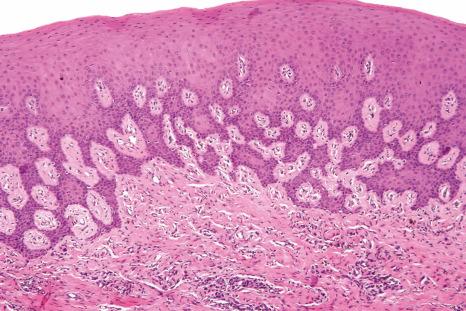
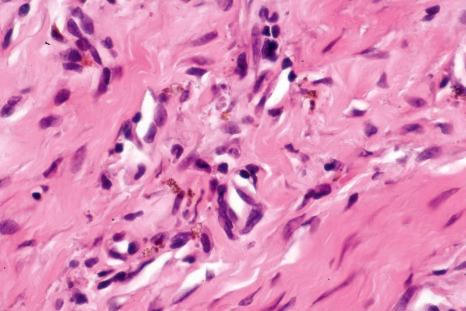
Plasma cell gingivitis, a contact hypersensitivity reaction, exhibits an intense polytypic plasmacytic infiltrate, usually in sheets, and foreign material is not identified.
This is the oral counterpart of pyoderma vegetans. Men are two to three times more commonly affected than women. The most common associations are ulcerative colitis (approximately 70%), Crohn disease (10–15%), and liver disease (21%). Patients present with numerous painful, shallow ulcers and erosions, miliary abscesses, and pustules that coalesce to form linear ‘snail track’ lesions ( Fig. 11.46 ). These develop on erythematous mucosa in which vegetations may be a feature. There is sometimes folding and fissuring of the buccal mucosa. The dorsal surface of the tongue is usually spared. Peripheral blood eosinophilia is present in 90% of cases.

There is acanthosis, sometimes accompanied by papillomatosis, and spongiosis. Suprabasilar clefting with acantholysis is usually seen ( Fig. 11.47 ). Characteristically, neutrophilic and eosinophilic abscesses are present in the connective tissue papillae at the interface, and sometimes within the epithelium ( Fig. 11.48 ). Eosinophils and neutrophils permeate the epithelium, and a mixed inflammatory infiltrate of lymphocytes, plasma cells, neutrophils, and eosinophils is present in the lamina propria.
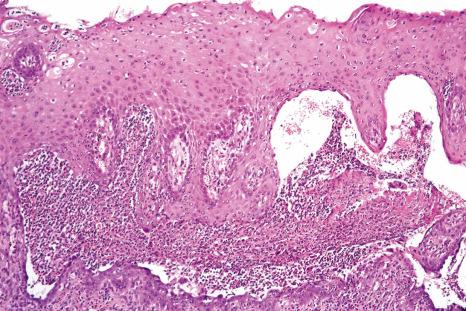
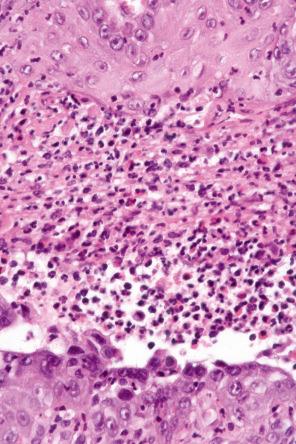
Direct immunofluorescence studies for IgG and C3 are negative. When positive, the staining is usually weak and represents a secondary reaction to epithelial inflammation and damage rather than a primary autoimmune phenomenon.
Pemphigus vulgaris exhibits acantholysis, but neutrophilic and eosinophilic abscesses are absent and papillary epithelial hyperplasia is not usually a feature. Pemphigus vegetans shows considerable histologic overlap although oral lesions are rare. Distinction from both of these conditions is readily made by direct immunofluorescence studies which show intercellular IgG deposition.
Warty dyskeratoma may exhibit the presence of corps ronds and grains without eosinophilic abscesses and negative direct immunofluorescence studies; clinically, it is a solitary keratotic papule or nodule.
This usually solitary lesion, sometimes referred to as oral focal acantholytic dyskeratosis, resembles Darier disease histopathologically, generally occurs in the fifth or sixth decade, and almost always arises on the keratinized and attached mucosa of the palatal mucosa or gingiva on the left side (buccal mucosa and tongue are much less frequently affected) with a 2 : 1 female predominance. Almost all are less than 1 cm in size; the papular variety appears as a white papule or plaque, while the nodular variety has an umbilicated or crateriform appearance. There is an association with tobacco use.
Similar to Darier disease, oral warty dyskeratoma is characterized by suprabasilar clefting, villous-like projections, and less often, corps ronds and grains; there may be papillary epithelial hyperplasia. In the nodular form, there is central umbilication filled with parakeratin.
Pemphigus vulgaris can be readily distinguished by the clinical history and the characteristic presence of intercellular IgG deposition on direct immunofluorescence. Pyostomatitis vegetans exhibits diffuse and not solitary lesions, with many eosinophils and neutrophils.
Nicotinic stomatitis (stomatitis nicotina) is associated with pipe smoking and its severity is proportional to the duration of the habit. Early lesions are reversible on habit cessation.
This is a condition seen in adults. Early lesions appear as small red punctate areas associated with diffuse and symmetric whiteness of the palatal mucosa. As lesions progress, the palatal mucosa takes on a cobblestone appearance with raised red and white papules having slightly umbilicated central puncta ( Fig. 11.49 ). The red puncta represent the inflamed ostia of the excretory salivary ducts.
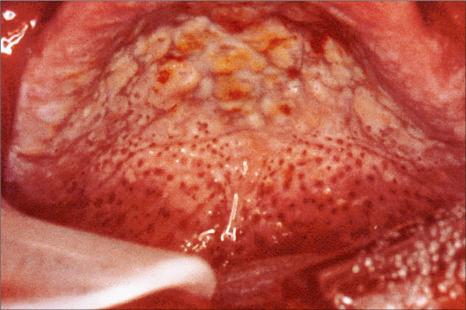
This condition is caused by the heat from the pipe smoke, and not nicotine. Similar changes have been described in patients who practice reverse smoking (smoking with the lighted end of the cigarette in the mouth as is common in parts of Asia) where the heat in the mouth is intense. This condition has also been noted in patients who consumed hot beverages.
There is parakeratosis or hyperkeratosis, and acanthosis. The papules represent openings of the excretory salivary ducts that have undergone squamous metaplasia, and the ductal epithelium exhibits leukocyte exocytosis and is surrounded by variable numbers of plasma cells and lymphocytes ( Figs 11.50 and 11.51 ).
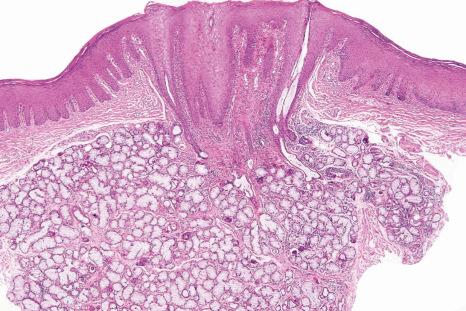
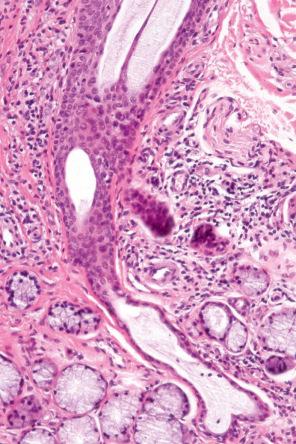
Dysplasia or even invasive squamous cell carcinoma may be present in patients who reverse smoke, but in general malignant change is not a feature in pipe smokers.
Recurrent aphthous stomatitis occurs in 15–20% of the adult population, with a slight female predilection. It first manifests in teenage years and early adulthood. It is a chronic, painful, relapsing, ulcerative condition of the nonkeratinized mucosa ( Fig. 11.52 ). There are four variants: minor, major, herpetiform, and severe.
Minor aphthous ulcers (the most common variant) are less than 1 cm, last 7–14 days, and heal without scarring; episode frequency varies and 10% of females report coincidence with the menstrual cycle.
Major aphthous ulcers are usually greater than 1 cm, last many weeks, and heal with scarring.
Herpetiform aphthous ulcers are less than 1 cm, and occur in small crops of 10–100 ulcers in any one episode.
Severe aphthous ulcers are similar to minor aphthous ulcers but patients have ulcers continuously without significant ulcer-free periods.
Most aphthous ulcers are idiopathic in nature although there is usually a strong family history of such ulcers. Ulcers become less frequent with age and will often resolve by middle age. It does not represent herpes simplex virus infection or any other infection although some believe Helicobacter plays a role.
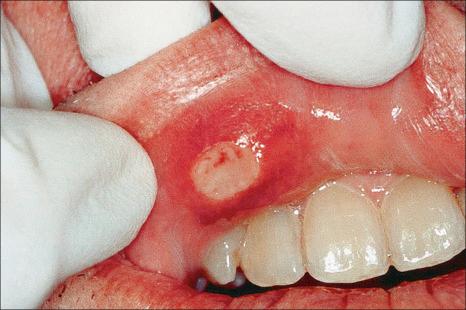
Some conditions frequently associated with aphthous-like ulcers include Behçet disease, hematinic deficiency (especially iron and vitamin B 12 ), inflammatory bowel disease, gluten-sensitive enteropathy, food hypersensitivity, HIV/acquired immunodeficiency syndrome (AIDS), neutropenia, and adverse effects of medications (such as nonsteroidal anti-inflammatory medications or mTOR inhibitors). Aphthous stomatitis presenting in association with rheumatological or mucocutaneous disorders is sometimes referred to as complex aphthosis. In children, aphthous stomatitis may be syndromic and associated with periodic fever, lymphadenopathy, and pharyngitis (PFAPA syndrome, a periodic fever syndrome). Interestingly, such patients often show complete response after tonsillectomy and/or adenoidectomy.
Cross-reaction of antigens of Streptococcus mutans with a mitochondrial heat shock protein may play an important role in the pathogenesis of this condition. Others believe there is reduced expression of heat shock protein 27 and IL-10. Expression of HLA class I and class II antigens on epithelial cells may result in targeting for cytotoxic attack. There is no evidence of increased circulating immunoglobulins or immune complexes.
The ulcerative process results from activation of the Th1 response leading to destruction of the epithelium. Early lesions show a predominance of T-helper cells followed by an increase in T-suppressor cells during the ulcerative phase; T-helper cells reemerge during the healing phase. Increased numbers of peripheral gamma-delta cells have been noted, suggesting that antibody-dependent cell-mediated cytotoxicity may play a role in the immunopathogenesis of this disease. Cell lysis may be mediated through tumor necrosis factor-alpha (TNF-α).
The histologic features are those of non-specific ulceration composed of a fibrin clot with enmeshed neutrophils and underlying granulation tissue with acute and chronic inflammation ( Fig. 11.53 ). The adjacent epithelium may exhibit reactive atypia, spongiotic pustules, and intraepithelial hemorrhage; viral cytopathic effect is not seen. Inflammation and degeneration of superficial skeletal muscle fibers may also be evident, but this should not extend into the deep muscle.
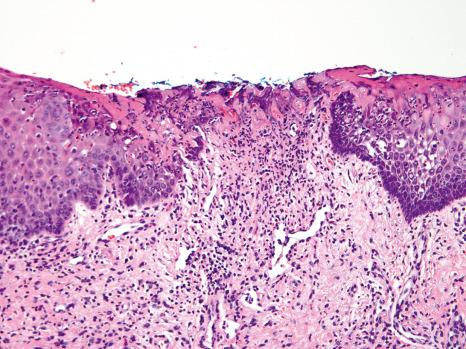
Traumatic ulcers and the ulcers of Behçet disease are histologically indistinguishable, and their distinction is dependent on clinical findings Sometimes, marked parakeratosis with superficial bacterial colonization is noted adjacent to the ulcer in traumatic ulcers. If there is inflammation of the muscle associated with a histiocytic infiltrate and eosinophils, a diagnosis of traumatic ulcerative granuloma is more appropriate (see below). If the fibrin clot and underlying granulation tissue contain few neutrophils, neutropenia-associated ulceration, such as is seen in HIV disease and cyclic neutropenia, must be considered.
Traumatic ulcerative granuloma (traumatic ulcerative granuloma with stromal eosinophilia, eosinophilic ulcer/granuloma of the tongue, Riga-Fede disease) occurs in two age groups. The less common form – and one that is not usually biopsied – occurs in infants in the first year of life. Painful ulcers occur on the ventral tongue or lower lip as a result of the child rubbing the mucosa against the developing lower anterior deciduous teeth (Riga-Fede disease). The second presentation, and the more common, is in the fifth and sixth decades of life, with ulcers occurring in males twice as frequently as females . The lateral tongue (up to 64% of cases), followed by the buccal mucosa, are most often affected. An ulcer or indurated area develops and persists for weeks or months ( Figs 11.54 and 11.55 ). The lack of pain, often a feature of this condition, raises the clinical suspicion of squamous cell carcinoma. A history of trauma is elicited in only 50% of cases. Lesions are often multifocal, and up to 30% of lesions recur.

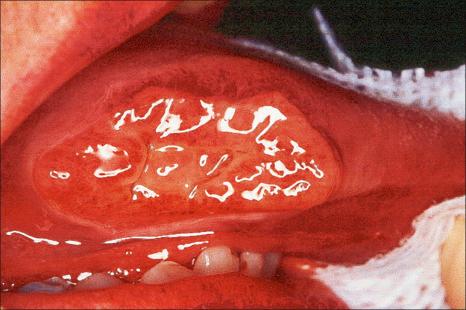
Lesions similar to this condition can be experimentally induced in animals by crush injury. It is likely that this is caused by penetrating inflammation that causes myositis whether this is brought on by chronic and repeated trauma (most common etiology) or some other ulcerative process (such as major aphthous ulcer) that is untreated or inadequately treated and becomes deep and penetrating. Infectious agents and foreign material have not been identified in these lesions.
There is an ulcer with abundant granulation tissue at the ulcer base accompanied by a polymorphous inflammatory infiltrate of lymphocytes and plasma cells, which extends into the underlying muscle ( Figs 11.56 and 11.57 ). The presence of many histiocytes and eosinophils in between degenerated and fragmented muscle fibers is characteristic ( Fig. 11.58 ). The muscle sometimes has a ‘checkerboard’ pattern from fragmentation. Lack of eosinophils especially in older lesions, does not preclude this diagnosis.
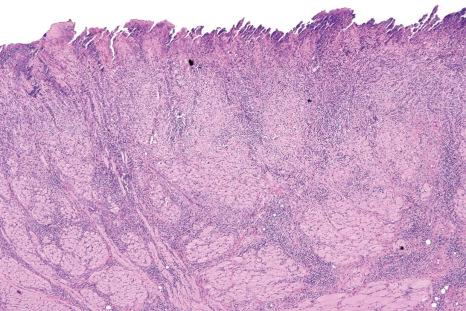
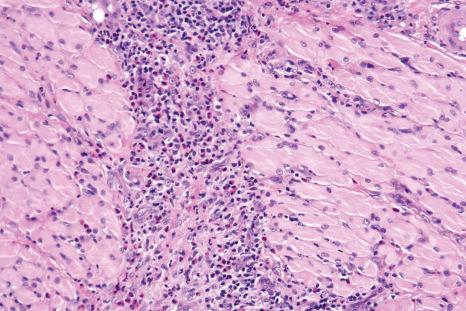
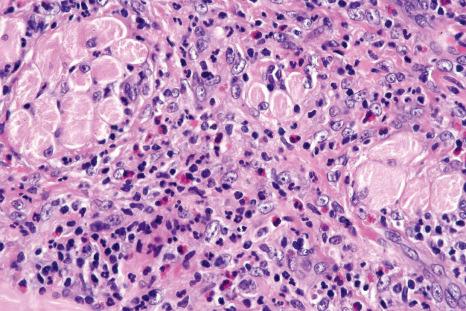
The large histiocytes express either CD68 and CD163, and some cells are positive for factor XIIIa. Scattered CD30+ cells may be present in this lesion but they should not be plentiful.
Conventional aphthous ulcers or traumatic ulcers may show inflammation of the superficial myocytes, but not deep penetrating inflammation noted in this condition.
Epstein-Barr virus-associated mucocutaneous ulcers are ulcers of the skin, oral or gastrointestinal mucosa that occur in immunocompromised patients (such as those on immunosuppressive therapy for autoimmune diseases), post-organ transplantation, in elderly, immunosenescent patients, or in patients with HIV/AIDS. They are also deeply penetrating with a polymorphous infiltrate, and exhibit atypical immunoblast-like lymphocytes and Reed-Sternberg-like cells ( Figs 11.59 and 11.60 ). They are positive for CD20, CD30, MUM-1, PAX-5, and Epstein-Barr virus ( Fig. 11.61 ). Some of these may have been referred to in the past as CD30+ traumatic ulcerative granuloma, atypical histiocytic granuloma, or pseudolymphoma. These may heal spontaneously, with reduction of immunosuppression or with definitive therapy. Rare cases represent CD30+ lymphoma.
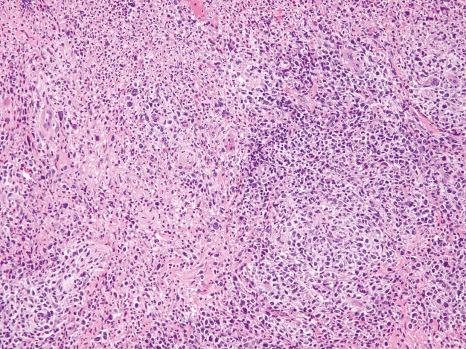
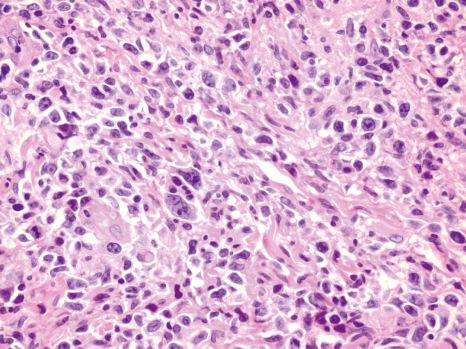
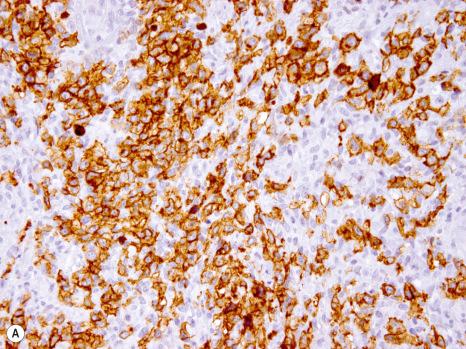
Epithelioid hemangioma (previously known as angiolymphoid hyperplasia with eosinophilia) may sometimes present in the lip and tongue. There is a proliferation of epithelioid endothelial cells forming vascular channels and intracytoplasmic lumina, that are positive for vascular markers. Lymphocytes, plasma cells, and eosinophils are commonly seen, and occasional lymphoid follicles with germinal centers are present ( Figs 11.62 and 11.63 ).
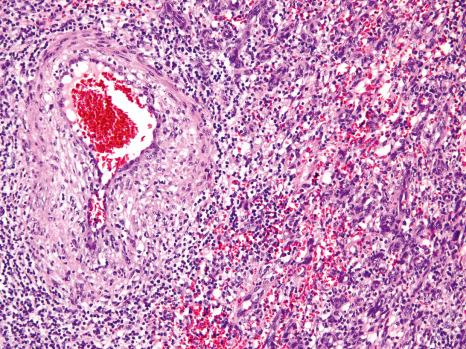
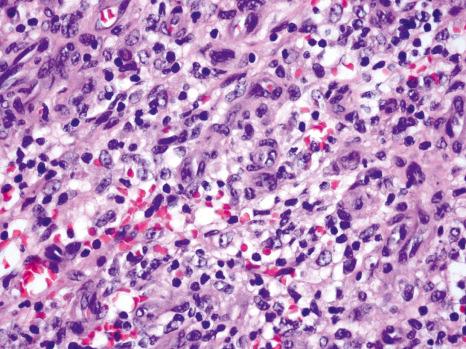
Histiocyte-like cells and eosinophils are a feature of Langerhans cell histiocytosis. However, Langerhans cells have the characteristic grooved nuclei and are positive for S100 protein, CD1a, and langerin (CD207) by immunohistochemistry.
Squamous papilloma generally presents in children and young adults in the second to fourth decades. Sites of predilection include the soft palate-uvula complex and the tongue, although any region in the oral cavity may be affected. Lesions may be white or mucosal-colored with a rough surface and finger-like projections ( Figs 11.64 and 11.65 ).
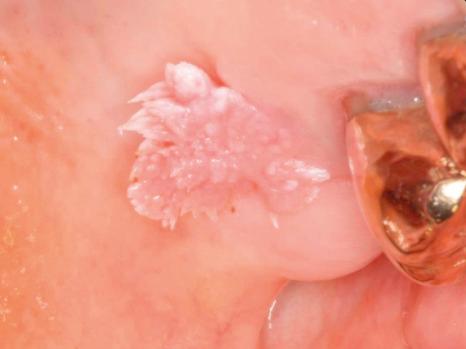
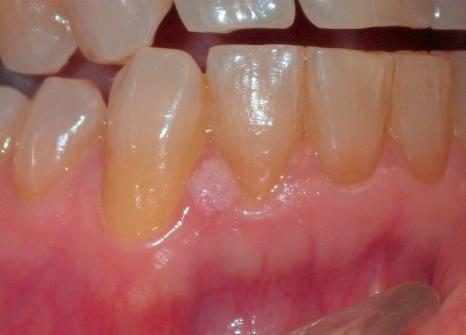
Lesions are caused by human papillomavirus (HPV) and in situ hybridization and polymerase chain reaction (PCR) studies have identified HPV (usually -6 and -11) in up to 67% of cases; HPV-2 is occasionally present.
The epithelium is thrown into uniformly thin papillary folds, and parakeratosis or hyperkeratosis is variably present. In general, papillomas arising from the uvula or soft palate tend to be nonkeratinized or only thinly keratinized with prominent keratinocyte edema ( Fig. 11.66 ). Koilocytes are not usually apparent. The connective tissue cores contain dilated capillaries, and there may be hyalinization. Inflammation and reactive basal cell hyperplasia and atypia may be present if the lesion has been traumatized.
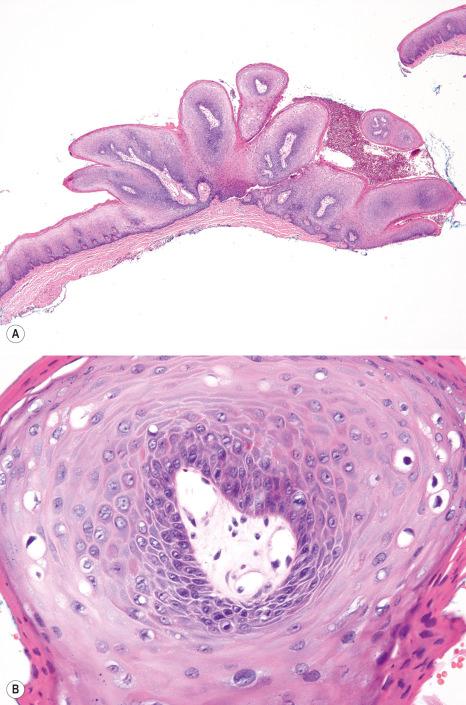
Verruca vulgaris may occasionally occur in the oral cavity and, as in the skin, it is characterized by marked hyperkeratosis with prominent coarse keratohyaline granules and axial inclination of epithelial papillary projections. HPV-2 is identified in up to 20% of cases of intraoral and up to 100% of lip verruca vulgaris.
Oral condyloma acuminatum shows large, bulbous rete ridges and prominent koilocytosis, and HPV-6 and -11 are often identified ( Figs 11.67 and 11.68 ). This condition occurs most frequently in patients who are on long-term immunosuppression such as organ transplant recipients.
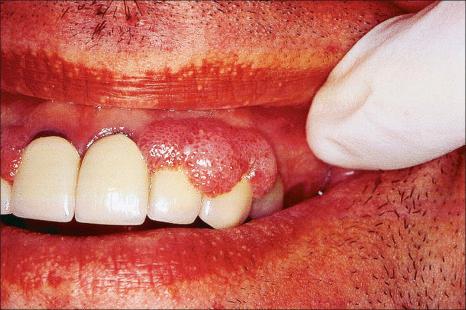
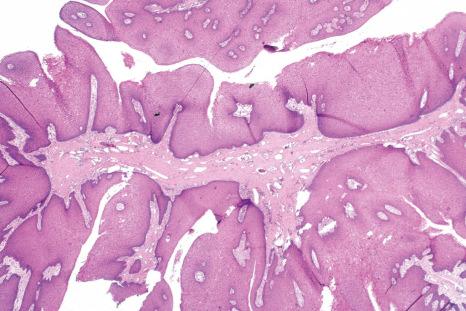
Focal epithelial hyperplasia (Heck disease), which is associated with infection by HPV-13, HPV-32, and HPV-55, is usually papular exhibiting acanthosis and uncommonly, papillary epithelial hyperplasia. Importantly, ‘mitosoid’ figures (cells exhibiting karyorrhexis) and apoptotic cells are characteristic features (see later)
Rare cases of oral acanthosis nigricans have been reported, and these are generally associated with gastrointestinal malignancy while the benign form is associated with diabetes mellitus, obesity, and hepatitis B.
Papillary hyperplasia caused by dentures consists of hyperplasia of both epithelium and fibrovascular tissue (see later).
Verruciform xanthoma affects adults in the fourth and fifth decades with no significant sex predilection. It presents as an asymptomatic, well-circumscribed rough, granular or pebbly, raised or depressed, yellowish or reddish plaque ( Fig. 11.69 ). Seventy percent occur on the hard palatal mucosa, gingiva, or alveolar ridge mucosa. Lesions on the skin (especially of the anogenital area) and other mucosal sites have also been reported. Although there is one report of a patient with multiple lesions and lipid storage disease, most patients do not exhibit hypercholesterolemia or disorders of lipid storage.
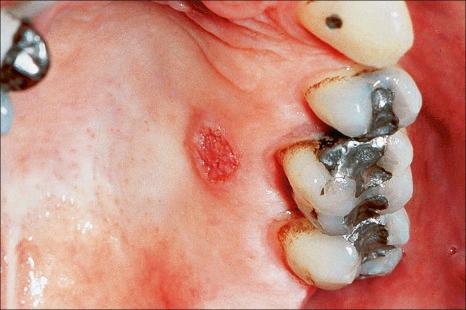
It has been postulated that verruciform xanthoma is a reaction to damaged and degenerated epithelial cells which release lipid that becomes engulfed by macrophages. Neutrophils are recruited to the area by the degenerating cells. The gingiva and palatal mucosa are constantly traumatized by mastication, and these are the common sites of occurrence for this condition. Verruciform xanthoma also occurs in association with other conditions where epithelial damage occurs such as lichen planus, pemphigus vulgaris, discoid lupus erythematosus, epidermolysis bullosa, and chronic graft-versus-host disease, as well as in dysplastic lesions and invasive carcinoma.
Histologically, there is parakeratosis with the parakeratin exhibiting a bright orange hue. Loose keratin squames are present on the surface or within epithelial crypts, and spongiotic pustules are common. The surface of a verruciform xanthoma generally has a papillary configuration although some lesions are flat. Rete ridges are uniformly long and sometimes coalesce at their bases ( Figs 11.70 and 11.71 ). Large, foamy, lipid-laden macrophages are found within the connective tissue papillae ( Fig. 11.72 ); occasionally, such cells extend beyond the deepest portion of the rete ridges or are seen within the epithelium. Rarely, nonmucosal cases may show a cystic and inverted, crateriform configuration.
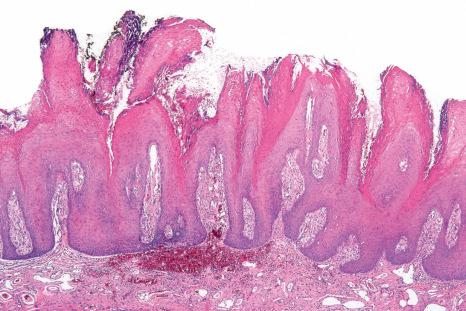
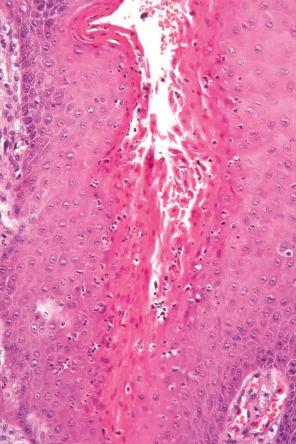
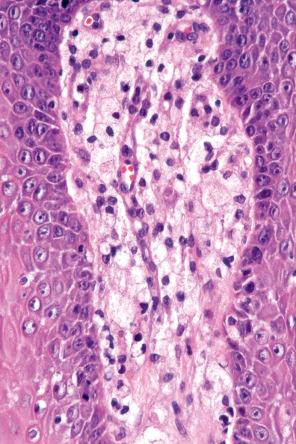
The xanthoma cells express CD68, CD163, and NK1C3 and are negative for S100 protein. Most of the xanthoma cells represent reparative (RM3/1) and resident (25F9) foam cells. Slight granular positivity for keratin within the foam cells also supports the presence of epithelial fragments. HPV immunohistochemistry is negative.
Ultrastructurally, the xanthoma cells contain membrane-bound granules consistent with lysosomes, myelin figures, and fragments of desmosomes, the last supporting the theory of phagocytosis of epithelial cell debris. There is fragmentation of the basal lamina and hemi-desmosomes.
This occurs most frequently in the second decade of life with 90% occurring below age 20 with a 2 : 1 male predilection. More than 80% occur on the maxillary marginal gingiva, and 15% are associated with orthodontic hardware. Lesions appear as nontender, erythematous, pebbly, sessile papules and plaques on the gingiva that infrequently are multifocal ( Fig. 11.73 ).
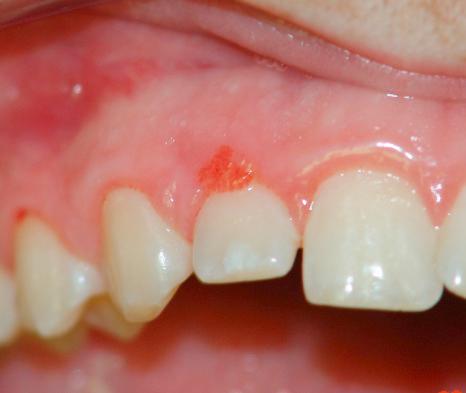
This is a reactive condition related to trauma and local irritation, and it has been suggested that the epithelial proliferation arises from the crevicular or junctional epithelium of the gingiva.
There is a pedunculated or sessile papillary proliferation of squamous epithelium with marked spongiosis and neutrophilic exocytosis with loss of surface keratin. Many dilated and congested capillaries are present within fibrovascular cores, sometimes with hyalinization ( Figs 11.74 and 11.75 ). HPV has not been consistently identified.
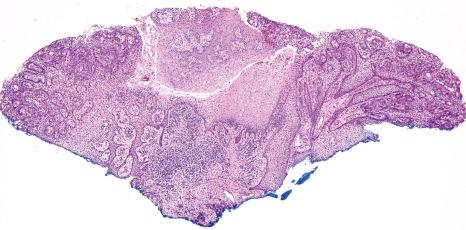
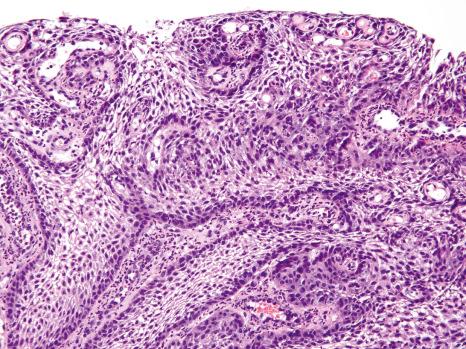
Fibroma (fibrovascular polyp, fibroepithelial polyp, irritation/bite fibroma) is the most common tumor-like (but non-neoplastic) condition in the mouth. It is usually located at sites of trauma, namely, the buccal mucosa at or near the linea alba, the lateral borders and tip of the tongue, the lower lip mucosa, and the gingiva. It presents as a fleshy, pedunculated, or sessile dome-shaped nodule that may be mucosal-colored, ulcerated or keratotic ( Figs 11.76 and 11.77 ).
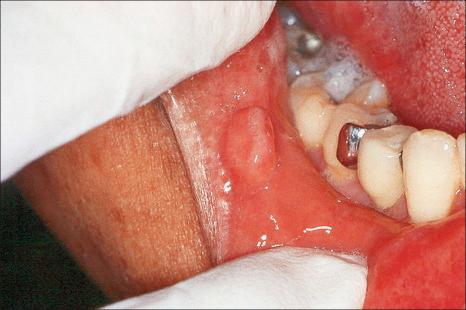
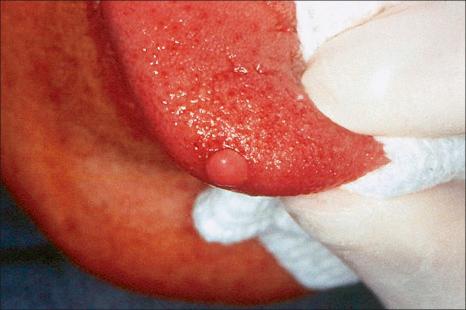
The fibroma is not a true neoplasm but rather a nodule of scar tissue caused by bite trauma.
The fibroma consists of a mass of fibrocollagenous tissue with variable vascularity and usually mild to insignificant inflammation unless there is overlying ulceration ( Figs 11.78 and 11.79 ). On occasion, the lesion may resemble a hypertrophic scar or keloid. The epithelium may be hyperkeratotic, acanthotic or atrophic. If adipose tissue is present, the term ‘fibrolipoma’ or ‘lipofibroma’ is sometimes applied.
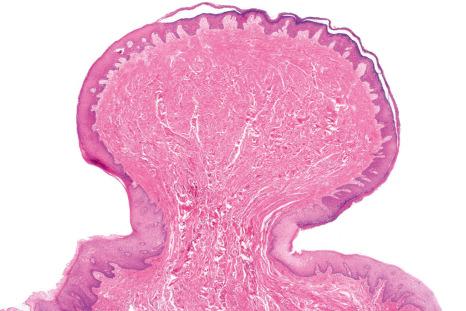
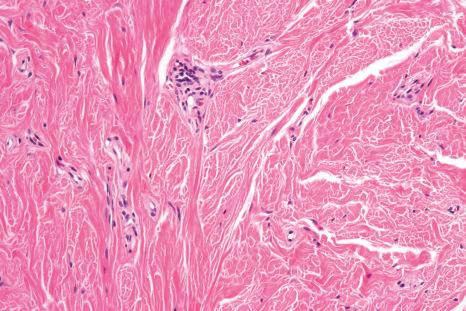
Sclerotic fibroma (storiform collagenoma) has been reported in the oral cavity, and the collagen in these lesions has a storiform appearance with clefts between hyalinized collagen and stellate or multinucleated fibroblasts with dendritic processes; multiple such lesions are seen in Cowden syndrome. The cells are sometimes positive for CD34.
Giant cell fibroma occurs in the first three decades of life, and the most common sites affected are the keratinized regions of the gingiva (44–49%), tongue (17–22%), and palatal mucosa (15–18%). It often has a papillary or bosselated surface. It bears some resemblance to the fibrous papule of the nose, angiofibroma, and the pearly penile papule. The retrocuspid papilla has a similar histology and is located on the lingual mandibular gingiva in the area of the cuspid.
The most characteristic feature of the giant cell fibroma is the presence of giant, stellate-shaped fibroblasts within densely collagenous stroma ( Figs 11.80 and 11.81 ). Multinucleated, stellate-shaped giant fibroblasts (‘manta ray cells’) are common. The overlying epithelium is usually hyperplastic, forming spiky, sawtooth-shaped rete ridges, and there may be surface papillomatosis.
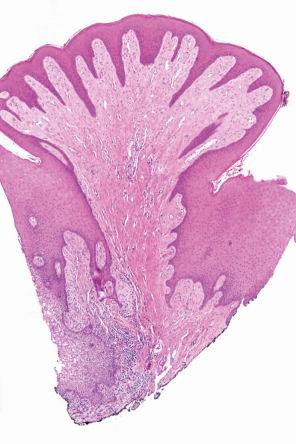
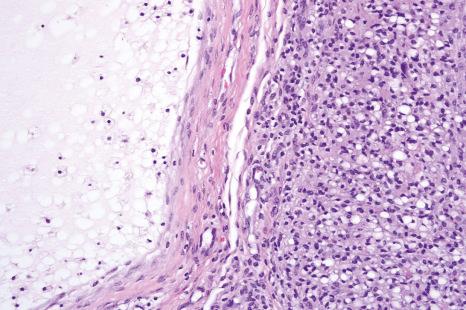
The cells express vimentin, occasionally factor XIIIa, but not S100 protein or CD68.
The multinucleate cell angiohistiocytoma occurs rarely in the oral cavity and contains multinucleated giant cells, branching capillaries, and myxoid stroma.
Lipoma usually occurs in adults in the sixth and seventh decades. It presents as a yellowish, soft and doughy, painless, sessile or pedunculated nodule that generally occurs on the buccal mucosa, tongue or oral vestibule ( Fig. 11.82 ). Other sites include the lips and floor of mouth. Infiltrating or intramuscular lipomas tend to occur two decades earlier and generally involve the tongue.
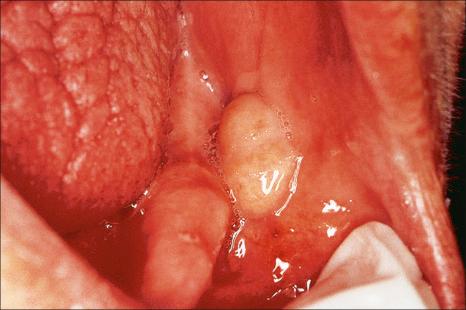
Many lipomas of the buccal mucosa are not true tumors but represent herniation of the buccal fat pad from trauma.
Become a Clinical Tree membership for Full access and enjoy Unlimited articles
If you are a member. Log in here